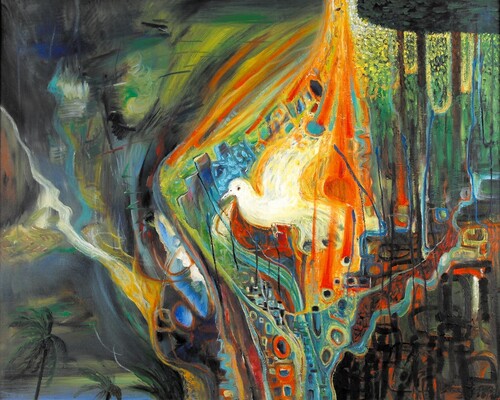PROFESSOR: LEE, SI-KA

![1.1 Li Xijia, Lonely Lonely Zheng, 2004, 100f [162x130cm], Oil on canvas, 2005. Description of the work: With the theme of jumping the river to the sea and river, there is an image of a small Taiwan, four peripherals symbolizing the image of human image, eyes, ears, mouth and nose, and the body dancing of men and women symbolizes the commotion of yin and yang lust in nature, representing the energy of nature and the longing for the dependence of the human world.Image](/var/file/223/1223/pictures/577/m/mcen500x500_large28711_587194949389.jpg)

![3. Li Xijia, Silent Earth, Oil on canvas, 2004, 130p [208x122cm], 2014. Description: This work is based on the night view of the sandbar after the tide recedes on the seashore of Changhua Lugang. In the painting, the dark night with clouds floating back and forth is made with a large brushwork, and the background and slight night under the moonlight show the vastness of the sea and sky, and the movement in the still night shows the vitality of the earth.Image](/var/file/223/1223/pictures/577/m/mcen500x500_large28713_967520349823.png)

PROFESSOR: LEE, SI-KA
Professor Li Xijia (1963-) is a native of Changhua. Bachelor of Arts, Master of Arts and Doctor of Philosophy from Chinese Culture University. He is currently a full-time professor in the Department of Fine Arts of the Chinese Culture University (teaching character No. 1 140577), and was an adjunct professor in the Department of Fine Arts and the Academy of Fine Arts of National Taiwan University of the Arts. He was twice awarded the Outstanding Teacher Award (108, 110) and was appointed as a consultant professor of the Teaching Advisory Group of the University of Arts (111, 112). His academic expertise is art introduction, curation, work analysis, oil painting creation, and Chinese and Western art appreciation. The painting style integrates Chinese and Western art philosophies. In addition to teaching and creation, he also invests in and promotes art education, has published numerous works and articles, and also serves as a jury member and consultant for major well-known art exhibition competitions in China. Li Xijia has held more than 12 solo exhibitions. His works have been selected for the Lion Newcomer Award (12th), selected for the Oil Painting Department of the North City Art Exhibition (14th), and served as an art critic: Zhou Chunya, Sato Gongcong, Li De, Liu Genggu and other well-known artists introduced and appreciated the works.
Related academic publications: Expressionism, Lao Zhuang Taoist Philosophical Aesthetics, Cézanne, Van Gogh, Meng Ke, Guo Baichuan, Mei Yuan, Li De, Liu Genggu, Wu Chengyan, Chen Jin etc., Overview of Taiwan's pre-war and post-war art.
Professor Li Xijia (1963-) is a native of Changhua. Bachelor of Arts, Master of Arts and Doctor of Philosophy from Chinese Culture University. He is currently a full-time professor in the Department of Fine Arts of the Chinese Culture University (teaching character No. 1 140577), and was an adjunct professor in the Department of Fine Arts and the Academy of Fine Arts of National Taiwan University of the Arts. He was twice awarded the Outstanding Teacher Award (108, 110) and was appointed as a consultant professor of the Teaching Advisory Group of the University of Arts (111, 112). His academic expertise is art introduction, curation, work analysis, oil painting creation, and Chinese and Western art appreciation. The painting style integrates Chinese and Western art philosophies. In addition to teaching and creation, he also invests in and promotes art education, has published numerous works and articles, and also serves as a jury member and consultant for major well-known art exhibition competitions in China. Li Xijia has held more than 12 solo exhibitions. His works have been selected for the Lion Newcomer Award (12th), selected for the Oil Painting Department of the North City Art Exhibition (14th), and served as an art critic: Zhou Chunya, Sato Gongcong, Li De, Liu Genggu and other well-known artists introduced and appreciated the works.
Related academic publications: Expressionism, Lao Zhuang Taoist Philosophical Aesthetics, Cézanne, Van Gogh, Meng Ke, Guo Baichuan, Mei Yuan, Li De, Liu Genggu, Wu Chengyan, Chen Jin etc., Overview of Taiwan's pre-war and post-war art.


